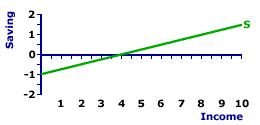
|
|
DEADWEIGHT LOSS: A net loss in social welfare that results because the benefit generated by an action differs from the foregone opportunity cost. This is usually the combination of lost consumer surplus and lost producer surplus, and indicates of the inefficiency of a situation. Deadweight loss is commonly illustrated by a market diagram if the quantity of output produced results in a demand price that exceeds the supply price. The triangle formed by the demand curve above, supply curve below, and quantity to the left is the area of deadweight loss. If demand price equals supply price, this triangle disappears and so too does the deadweight loss. Deadweight loss can result from government actions (taxes, price controls) or from market failures (externalities, market control)
Visit the GLOSS*arama
|
|


|

|
                           INTERCEPT, SAVING LINE: The intercept of the saving line indicates autonomous saving, saving that does not depend on the level of income or production. This can be thought of as the baseline level of saving that would be undertaken if income falls to zero. Autonomous saving is affected by the consumption expenditures determinants, which cause a change in the intercept and a shift of the saving line. The value of the intercept of the saving line is the negative of the value of the intercept of the consumption line. | Saving Line | 
|
The saving line, also termed propensity-to-save line or saving function, shows the relation between saving and income for the household sector. The income measure commonly used is national income or disposable income. Occasionally a measure of aggregate production, such as gross domestic product, is used instead.A representative saving line is presented in the exhibit to the right. This green line, labeled S in the exhibit, is positively sloped, indicating that greater levels of income generate greater saving by the household sector. This positive relation corresponds to the fundamental psychological law of Keynesian economics. The saving line graphically illustrates the saving-income relation for the household sector, which is the foundation of the leakages line used in Keynesian economics to identify equilibrium income and production. The intercept of the saving line indicates the intersection point between the saving line and the vertical saving axis. The saving line intersects the vertical axis at a value of -$1 trillion. Theoretically, this is a minimum "baseline" level of saving, the amount of saving undertaken if income falls to zero. This level happens to be negative because consumption exceeds income. More to the point, this intersection indicates autonomous saving--saving unrelated to income. Click the [Intercept] button to illustrate. Autonomous saving is saving by the household sector that is unrelated to and unaffected by the level of income or production. This is best indicated by a zero level of income. While individuals occasionally come face-to-face with autonomous saving, as their incomes drop to zero due to unemployment, for the aggregate economy autonomous saving is mostly an unlikely theoretical extrapolation. However, from an analytical perspective, the intercept of the saving line is affected by the consumption expenditures determinants. These are ceteris paribus factors other than income that affect consumption and thus also affect saving, but which are held constant when the saving line is constructed. Any change in these determinants cause the saving line to shift, which necessarily means a new intercept and a new level of autonomous saving.

Recommended Citation:INTERCEPT, SAVING LINE, AmosWEB Encyclonomic WEB*pedia, http://www.AmosWEB.com, AmosWEB LLC, 2000-2025. [Accessed: July 18, 2025].
Check Out These Related Terms... | | | | | | | | | | | | | | |
Or For A Little Background... | | | | | | | | | |
And For Further Study... | | | | | | | | | | | | | | | |
Search Again?
Back to the WEB*pedia
|



|

|
BLUE PLACIDOLA
[What's This?]
Today, you are likely to spend a great deal of time searching the newspaper want ads looking to buy either a wall poster commemorating the first day of winter or blue cotton balls. Be on the lookout for rusty deck screws.
Your Complete Scope
This isn't me! What am I?
|

|
|
The wealthy industrialist, Andrew Carnegie, was once removed from a London tram because he lacked the money needed for the fare.
|

|
|
"A winner is someone who recognizes his God-given talents, works his tail off to develop them into skills, and uses those skills to accomplish his goals. " -- Larry Bird, basketball player
|

|
IER
International Economic Review
|

|
|
Tell us what you think about AmosWEB. Like what you see? Have suggestions for improvements? Let us know. Click the User Feedback link.
User Feedback
|


|


